I Am... Miso Tuna Salad
Tuna salad is a vibe. Those who love it love it and those who hate it just haven’t tasted the right tuna salad. I love it and I pretty much always have. Give me a tuna melt and I’m in HEAVEN. This miso tuna salad has been my go to forever because: miso! Miso makes everything better, it adds depth, umami and healthy probiotics.
The best tuna salad
This tuna salad is a simple mix because it’s one of my go-tos when I’m hungry but don’t have any groceries. It’s a little umami bomb and absolutely the perfect moreish no-carb snack. To a can of drained tuna, I stirred in a little bit of kewpie mayo, white miso instead of salt, celery for crunch, and green onions for bite. Crisp seaweed snacks are the best for scooping it up! It’s also amazing on super soft Japanese fluffy bread, toasted sourdough, or sourdough crackers.How to make miso tuna salad
- Super simple: mix together the miso and Kewpie until smooth and then add tuna, diced celery, and sliced green onions. Season with freshly cracked black pepper and enjoy!
Miso tuna salad ingredients
- miso - a traditional Japanese seasoning that is pretty much found everywhere now, miso adds depth and salty umami to this tuna salad. It adds a rich savoriness and as a bonus you don’t need to season with salt.
- kewpie mayo - this is a no brainer, kewpie mayo is so delicious, more on that below!
- tuna - you can use any tuna you like, we’re going to drain it so it doesn’t matter too much. I usually go with a chunk tuna as opposed to flaked. I like tuna packed in water, usually light tuna because it’s supposed to have less mercury. If you want your tuna a bit more rich, you can always add more kewpie but you can’t control the flavor of oil packed tuna.
- celery - tuna salad isn’t tuna salad without celery to add crunch.
- green onions - sliced them up and add them for freshness and a bit of oniony bite
- pepper - freshly cracked of course!
White or red miso
For tuna salad I like to reach for a white miso, which is mellow and sweet. It’s called shiro miso or sweet miso and you can find it near the tofu at places like Whole Foods or at Asian grocery stores.Which mayo to use
Kewpie mayo, forever and always! If you’re not a mayo fan, you have to try Kewpie mayo: the ubiquitous clear, red-topped squeeze bottle of mayo found in practically every Japanese household. It’s tangy from rice vinegar, slightly sweet, and extra creamy. It is absolutely delicious and will take this salad to the next level! Read more about kewpie here.What else can I make with kewpie mayo?
You can use kewpie mayo anywhere you would use regular, but here are some recipes to get you started:- Mayo ramen – for an extra rich luxe restaurant style ramen
- Ebi chili mayo – Deep fried tempura prawns with sweet and spicy Kewpie
- Japanese Egg Sando (or this one) – Japanese egg salads aren’t Japanese unless you use Kewpie. This is gonna be the best egg salad you’ll ever taste
- Japanese potato salad – It just hits different. It’s the Kewpie!
- Takoyaki – the classic takoyaki topped with Kewpie
- Deviled eggs – eggs get an upgrade with Kewpie mayonnaise
- Sushi bake – because it’s the creamiest, warmest, most satisfying casserole
Miso Tuna Salad
Miso makes everything better, it adds depth, umami and healthy probiotics.
- 1 tbsp white miso
- 2 tbsp kewpie mayo
- 1 can tuna (drained)
- 2 tbsp celery (diced)
- 2 tbsp green onions (sliced)
- freshly ground pepper (to taste)
Mix together the miso and kewpie until smooth. Add the drained tuna, celery and green onions.
Mix throughly and season to taste. Enjoy on its own or on top of crackers, toast, or seaweed.
Adjust the miso content to taste, miso pastes vary greatly in terms of saltiness. Also, feel free to add more kewpie mayo if needed.
I Am... Roasted Honeynut Squash Creamy Pasta
It’s honeynut squash season! Mike and I went to the farmer’s market the other day and there was a perfect little basket of the tiniest honeynut squash. I absolutely love honeynuts so of course I squealed and went about picking out the cutest most tiniest ones. If you’re not familiar with honeynut squash, they’re like tiny butternut squashes, with the same shape. They were created to be a tiny, tasty squash and they are. They’re sweeter and when cooked, take on a caramel almost malty flavor. They’re super tender and cook very quickly because they’re so small.
A fall inspired pasta
After roasting a couple and eating them as is, I thought it would be nice to make a fall inspired pasta. I cut the squash up in a thick matchstick then pan-roasted them in a generous amount of olive oil. They got blistered and caramelized and so good. From there, I made a simple cream sauce then tossed in some greens and pasta. So cozy and perfect scooped up into a bowl!Why you should make a squash pasta:
- You love fall and you want to get cozy with a big bowl of pasta and squash
- You want to feed someone vegetarian food and you want it to taste good
- Honeynut squash gets you excited
- You want a hearty pasta that’s also just a little bit heathy
- You love garlic cream sauce
Frequently asked questions
Q: I can’t find honeynut squash at the store, what can I use instead? A: Any squash will work for this – try butternut or kabocha. Just make sure you cut it smaller so that it cooks just as quickly in the pan. Q: Why does the pasta look pink? A: I had no idea that swiss chard would make the cream sauce so pink! Next time I would definitely stick to kale or something. Q: What is the pasta shape called? A: It’s one of my all time favorite pasta shapes called calamarata! They’re supposed to look like calamari rings and I love them so much. Q: Why are you pretending that people ask you these questions? A: I like to amuse myself and for some reason I find this format hilarious >_< Happy honeynutting! (that sounds wrong LOL) xoxo steph PS - If you love honeynut squash as much as I do, try this honeynut squash with honeyed walnuts I made last year!Pan-Roasted Honeynut Squash with Creamy Garlicky Pasta
A warm and comforting pasta dish with all the flavors of fall, including honeynut squash
- 1-2 small honeynut squash (cut into thick matchsticks)
- 2 tbsp olive or neutral oil
- salt and freshly ground pepper
- 6 ounces dried pasta of choice
- 1 1/2 cups leafy greens (chopped)
- 3/4 cup heavy cream
- 4 cloves garlic (minced or crushed)
- 3/4 cup finely grated parmesan
Heat up the oil over medium high heat in a skillet. Add the honeynut cubes in a single layer and sear, stirring once or twice, for 5 minutes. Lower the heat to medium and cook until fork-tender, about 5-6 minutes, stirring as needed. Season with salt and pepper.
Meanwhile, cook the pasta 2 minutes shy of al dente in a large pot of salted water. Reserve 3/4 cups water and drain.
When the squash is done cooking, scoop the squash out of the pan and set aside. Add the cream and garlic to the same pan over medium heat and simmer until slightly reduced, 2-3 minutes.
Add the pasta and 1/2 cup pasta water to the sauce and bring to a boil, cooking, stirring occasionally, until the pasta is al dente and the sauce coats the pasta, about 2 minutes. Add more pasta water if the sauce starts to get too thick.
Stir in the greens until wilted, then turn the heat down and stir in the cheese until melted.
Add the honeynut squash, season with salt and pepper and enjoy immediately!
I Am... Butter Candle
Move over butter boards, the butter candle is here! They add light, ambiance, and, of course, butter to any table, making serving bread, steak, or anything you love to dip in butter a fun and interactive experience. If you love warm butter and fresh bread, or you love butter boards, you’ll love the butter candle.
What is a butter candle?
It’s exactly what it sounds like: a candle made of butter. A food safe wick is lit at the table and the butter slowly softens, making the butter melty, dippable, or pourable. Butter candles are typically served with bread, but you can also serve them with anything that you love with butter. For dipping you can go with: seafood, vegetables, or meats. And for pouring, think: mashed potatoes, rice, popcorn - the list goes on and on. Is there anything that doesn’t taste better with butter?Who invented butter candles?
To be honest, butter candles are a modern take on delightfully retro tallow candles, which are candles made out of beef fat. Tallow candles have existed for ages, since Ancient Rome, in fact. Lately, adventurous restaurants have started serving steak with highly flavorful edible tallow candles. The resulting melty, warm beef fat is poured over steak or served alongside potatoes. Really, it’s not that big of a jump to homemade butter candles for bread. The first version I saw on Tiktok was by Soozie the Foodie who serves hers with bread. The other one I see on repeat is the steak butter candle by SAMO. These two Tiktoks are perfect examples of the two different ways you can make butter candles.How to make a butter candle
There are two ways to make a butter candle: hand shaping and pouring. Both work well, but hand shaping is a bit more rustic looking and if you don’t have food safe gloves, I recommend going the pouring route.To hand pour a butter candle
This is definitely the easiest way to make a butter candle. Melt the butter, make a wick out of food safe twine, pour the butter in a container, and wait for it to set. That’s it!- Melt the butter. You can do this in a small pot over low heat on the stove, or in 20 second increments in the microwave, stirring every time you reset the microwave.
- Make the wick. Cut a piece of food safe string and dip it into the melted butter to create a food safe wick.
- Set the wick in the mold. Tie the buttered string around a stick or chopstick and place the stick over the top of your butter candle mold, making sure the string touches the bottom of the mold.
- Pour in the butter. Pour the melted butter into the mold, making sure the wick is in the centre of the candle.
- Let the candle set. Place the butter candle in the fridge until it’s nice and firm, at least 1 hour minimum.
- Light your butter candle on fire and enjoy. When it’s time to enjoy, remove the stick and trim the wick so it’s about 1/4 - 1/2 inch above the candle. Use a match or lighter to light the wick and let the butter melt. Enjoy the melted butter by dipping or pouring!
To hand shape a butter candle
Start with slightly soft spreadable butter. Ideally, take your butter out of the fridge and let it sit a room temp, for 20 minutes. Lay out a piece of plastic wrap and place your stick of butter in the middle. Use your hands or a rolling pin to lightly flatten the butter and place a piece of kitchen string in the middle for a wick. Use the plastic wrap to roll and shape the butter into a candle. Place in the fridge to set.Butter candle wicks
It doesn’t matter if you hand shape or pour, either way, you’ll need a food safe wick. My suggestion is 100% cotton food safe twine, the kind that you tie up roasts and chicken with. You can find it near the meat section in the grocery store or you can order it online. Because it’s food safe, it will be safe when you light your candle. All you need to do to make your food twine into a wick is dip it in melted butter so it holds a flame better.Butter candle molds
You can go store bought or homemade here. Your mold really depends on if you want to have a free standing (de-molded) candle or a candle in a container. Generally, you want a free standing or shallow candle for dipping and a container candle for pouring.Dippable butter candle mold
Depending on if you want to un-mold your candle or not, you’ll want either a disposable or reusable mold. If you’re going to un-mold your candle, you can use a paper cup that you can cut and then peel away from the butter. You can even make a cardboard tube, line it with parchment paper and tape on a bottom. If you’re going for a dippable candle that you’re going to leave in the mold, go for a shallow container that you already have at home like a ramekin or small dish. This butter crock would work amazingly for a dipping butter candle.Pourable butter candle mold
These can be anything small with a spout. We use a tiny cream pitcher, which worked really well and is incredibly cute. Anything small and pourable is useable. Small cream pitchers or espresso pourers are great and there are so many out there. These mini glass espresso pouring cups with wooden handles are super cute.Salted or unsalted butter
Most people will tell you to go with salted butter because that’s what you serve with bread, but unsalted works too, just serve your candle along with some flaky sea salt. Really, use whatever butter you love.What to serve with butter candles
Really you can serve anything. If you’re going for a starter, a nice selection of crusty breads works well. On the other hand, if you want to serve up a butter candle at breakfast or brunch, pancakes, waffles, or freshly baked muffins come to mind. If you’re serving it with dinner, melted butter tastes amazing on rice, noodles, vegetables, seafoods, and meats. Classic is a herbed butter with steak frites, you can’t go wrong with that!Butter candle flavors
Any compound butter (flavored butter), can be a butter candle. To make, simply stir the ingredients into the melted butter.- garlic butter: 1/2 cup butter plus 4 cloves finitely minced garlic or 4 cloves roasted garlic
- herbed butter: 1/2 cup butter plus 2 tbsp freshly chopped herbs of choice such as mint, cilantro, green onions, rosemary, thyme, flat leaf parsley, sage, basil, dill, tarragon, chives
- jalapeño butter: 1/2 cup butter plus 2 tbsp finely chopped jalapeño
- paprika butter: 1/2 cup butter plus 1 tsp smoked paprika and 1 tbsp fresh parsley
- shallot butter: 1/2 cup butter plus 2 tbsp finely chopped shallots, 2 cloves finely minced garlic, 2 tsp finely minced parsley
- red wine butter: 1/2 cup butter, 2 tbsp red wine, 1 tbsp finely chopped shallots, 2 tsp finely chopped parsley, 1 tsp fresh lemon zest
- lemon butter: 1/2 cup butter, 2 tbsp fresh lemon juice, 2 tsp fresh lemon zest, 2 tsp finely chopped parsley
Pro tips
- Make sure your butter candle is solid before lighting it up, otherwise you’ll just have a butter pool as opposed to a candle.
- If you’re un-molding your candle, place the candle in a shallow dish with a lip so that as it melts, it doesn’t overflow and cause a butter spill.
- Start small! Yes, you can make a butter candle with 1 pound of butter, but that’s excessive, even in this day and age. All you really need is one stick of butter (which is a 1/2 cup).
- Super smooth butter candles. If you’re a purist and want a very clean burning, pretty candle, be sure to clarify and strain your butter. Because butter has water content and milk solids, a non-clarified butter candle will sputter a little due to the milk solids. This is definitely an optional step thought and I don’t think it’s necessary.
How to Make a Butter Candle
Move over butter boards, the butter candle is here!
- Food Safe Kitchen Twine
- Small Ramekin
- 1/2 cup butter
- 1 baguette (sliced, to serve, optional)
Make your wick: tie a knot in your kitchen twine and trim off the excess, then measure out about double the height of your candle. Tie the newly cut end in a knot around your chopstick, leaving a length the same height as your candle with the original knot on the other end. Trim the excess and set aside.
Gently melt the butter in a pan on the stove over low heat. You can also melt it in the microwave in 30 second increments.
Drag the wick through the melted butter, making sure it’s saturated as close to the chopsticks as possible.
Set the chopstick over your ramekin, moving the string if needed so that it’s centered in the mold.
Pour in the butter and let set until solid in the fridge, minimum 1 hour.
To enjoy, remove the stick and trim the wick down to about 1/2 inch. You can light the butter candle as is, in the mold, or take it out of the mold by dipping the dish in warm water and running an offset spatula around the edges.
Light the candle and watch it burn as the butter melts. Enjoy with fresh crusty bread.
I Am... Pumpkin Butter
There’s nothing quite like a fresh cup of coffee and a thick slice of toast slathered with pumpkin butter on a crispy, sunny, fall day. It’s pumpkin season! The coziest, most snuggly -dare I say- tastiest time of the year? It makes me smile just thinking about sinking my teeth into a plush piece of crisp and soft toast with pumpkin-spiced butter melting into all the little nooks and crannies.
What is pumpkin butter?
Pumpkin butter is a spread made with pumpkin, pumpkin spices, sugar, and of course, butter. It’s sweet, rich, and absolutely delicious. Think how life would be if you could take pumpkin pie and just spread it on toast. It’s kind of like that but a bit lighter, less dense, and more spreadable.Is there butter in pumpkin butter?
Yes! There is butter in this version of pumpkin butter because without butter is it even technically pumpkin butter? That being said, there are versions out there that don’t have butter in them (I’m looking at you Trader Joe’s, more on that below). I suspect that they didn’t put butter in theirs so they could have a shelf-stable, more jam-like product. Without butter, it’s more of a fruit spread. Both are delicious, but pumpkin butter with actual butter in it is amazing on warm baked goods or toast. The butter melts down into all the nooks and crannies and infuses spiced pumpkin flavor into whatever you spread it on.Pumpkin butter ingredients
All you need is pumpkin, pumpkin spice, vanilla, and butter:- puréed pumpkin - get the small 15-ounce can of pure pumpkin. I love Libby’s, which is straight-up pure pumpkin - Dickinson squash pumpkin to be exact.
- pumpkin spice - if you have pumpkin spice in your pantry, perfect! If you don’t, it’s super easy to whip some up. Pumpkin spice is going to add warmth and spiciness to our butter.
- vanilla - just a touch of vanilla is going to bring out the warmth of all the spices and add that baked goods feel.
- butter - it just isn’t pumpkin butter without butter! Use a high-quality butter that you love the taste of. It’s up to you if you use salted or unsalted, but I feel like salted helps emphasize the other flavors. Make sure your butter is at room temp so it’s easy to mix and incorporate with the brown sugar.
- brown sugar - brown sugar is going to give us a caramel sweetness that you don’t get with granulated sugar. But, if you only have granulated sugar at home, that will work too!
How to make pumpkin butter
- Reduce - add pumpkin, pumpkin spice, and a bit of vanilla to a pot or pan. Turn the heat up to medium and stir and cook the pumpkin until it reduces into a thick, and smooth paste. The key is to cook all of the water content out of the pumpkin so you’re left with pure pumpkin flavor. I like to use non-stick and I prefer using a pan because the increased surface area makes it easier to reduce the pumpkin. But using a larger pan means more splattering as the pumpkin is cooking down. The pumpkin will bubble and splatter, so keep that in mind!
- Cool - once the pumpkin is smooth and thick, spread the spiced pumpkin on a plate to help it cool down.
- Whip - Once the pumpkin is completely cool, whip together the brown sugar and butter. You don’t need to make sure it’s creamed, if you see granules of brown sugar in the butter, that’s perfect! Once the butter and sugar are one, mix in the cooled, spiced pumpkin and mix thoroughly.
- Enjoy - Once it’s ready, you can spread it on anything and everything! If you don’t use all of it right away, just spoon it into an airtight jar or container and keep it in the fridge for up to two weeks. Before you use it, you can whip it up to make it super smooth, or you can use it cold from the fridge. For me, there’s something about cold butter on hot toast or hot pancakes. I live for that contrast!
How to use
Spread a thick layer on fresh bread, toast, bagels, french toast, waffles, pancakes, slices of loaf cakes, buns, basically anything you would use butter on. For extra deliciousness, finish with a shower of cinnamon spice.Homemade pumpkin spice mix
It’s super simple to make homemade pumpkin spice mix and if you do it yourself, you won’t have a whole bottle sitting in your pantry just waiting for fall. For 1 tablespoon of pumpkin spice, mix up: 2 tsp ground cinnamon, 1/2 tsp ground ginger, 1/2 tsp ground nutmeg, 1/4 tsp ground cloves, and 1/4 tsp allspice.Trader Joe’s Pumpkin Butter
Trader Joe’s is dairy-free and doesn’t have butter in it at all. Instead, it’s kind of a pumpkin spread that’s a tiny bit thick, seasoned with pumpkin spice and sweetened with sugar and honey. Think of it like pumpkin jam. If you’re dairy-free, you can make the butter recipe below by adding the sugar to the pumpkin when you’re cooking it and skipping out on mixing in the butter. Personally, I prefer it when it actually has butter in it because it adds that decadence and luxuriousness that is absolutely necessary for a spread.If you love pumpkin and pumpkin spice, please check out these other recipes
- homemade pumpkin cream cold foam
- the plushiest, softest, pumpkin loaf
- irresistible pumpkin cheesecake bars
- mini, fluffy pumpkin chocolate chip pancakes
- super moist and delicious pumpkin cupcakes with brown butter frosting
Pumpkin Butter
Sink into a plush piece of toast with pumpkin-spiced butter melting into all the little nooks and crannies.
- 15 oz puréed pumpkin (~1 can)
- 1 tbsp pumpkin spice
- 1 tsp vanilla extract
- 1 cup butter (room temperature (2 sticks))
- 1/2 cup brown sugar (light preferred)
Add the pumpkin puree, pumpkin spice and vanilla to a non-stick pan and cook, stirring frequently, over medium heat for 15-20 minutes, or until smooth, thick, and reduced. The pumpkin will spatter and bubble as the water cooks out, so be sure to stir and keep an eye on it.
When reduced, remove from the heat, and spread the pumpkin out onto a plate to cool.
When the pumpkin is completely cool, cream together the butter and brown sugar in a large bowl, or the bowl of a stand mixer until combined. Add the cooled pumpkin puree and mix until completely incorporated.
Enjoy immediately or spoon into a jar or air-tight container and keep in the fridge to use on anything and everything. The pumpkin butter will keep well in the fridge for up to 2 weeks.
I Am... Mummy Dogs
Mummy dogs are not only cute and spoopy, they’re also super delicious. I’m obsessed with Halloween food. Give me all the themed parties with foods dressed up as other things. Halloween is one of the best – if not the BEST – holidays for dressing up food. Think: chewy chocolate cookies with googly eyeballs, sushi that looks like Totoro, and of course, mummy dogs! Imagine juicy hot dogs wrapped up with strips of buttery pastry and baked to golden brown perfection. Serve them up with mustard or sweet-n-spicy ketchup for the perfect handheld snack on your Halloween table.
What are mummy dogs?
A classic favorite for Halloween parties, mummy dogs are a take on pigs-in-a-blanket, but with a fun twist. Instead of making a blanket of pastry dough it’s cut it into strips. The strips wrap around hot dogs and bake up to look like a bandaged wrapped mummy. When you add on eyes, they’re unbearably cute.How to make mummy dogs
- Cut pastry into strips. You want about 1/4 inch strips of either puff pastry or crescent dough. If you’re feeling especially industrious, you can even make your own pie crust or rough puff pastry.
- Wrap the strips of pastry around the hot dogs, leaving a space for eyeballs about 1 inch down from the top of your mummy.
- Place the wrapped hot dogs on a parchment paper lined baking sheet and bake in a 375°F oven until golden brown.
- Remove, put on some eyeballs, and enjoy!
Mummy dog ingredients
This is the best part: you only need 2 ingredients: pastry and hot dogs. If you’re going to use candy eyes, you’ll need those as well.What kind of hot dogs?
Your favorite hot dog brand will work best. Classic all beef, pork, chicken, or turkey dogs work. You can even go with mini smokies for mini mummies.What kind of pastry for mummy dogs?
- Crescent dough - the classic mummy dog. You can either buy crescent rolls or crescent roll sheets. If you can find crescent dough sheets, they work well because you don’t have to roll out the dough or pinch together the triangle seams.
- Puff pastry - puff pastry is delicious and will give you a slightly puffier mummy with a flaky shattering bite.
- Pizza dough - pizza dough tends to bake up thick and is more filling. You can use your favorite pizza dough recipe or buy store bought dough.
- Pie crust - strips of pie crust are perfect for mummy dog pies.
How to make the eyes
I like using candy eyeballs because they’re so cute. Plus they’re so small that they don’t really effect the taste. You can also pick them off if you’re adverse to eating them. If you don’t want to buy candy eyes, you can also just dot on mustard. Or, use a small cookie cutter to cut out eyeball whites out of a slice of mozzarella cheese and use seaweed for irises.How to serve
These little guys taste great warm out of the oven or at room temp. Place them on a platter with small dipping bowls of ketchup and mustard. Mummy dogs are also perfect on Halloween platters.Variations
Cheesy mummy dogs Cut slices of cheese the same size as your hot dogs. Place the cheese under the hotdog and wrap with the crescent dough. Bake as per the recipe. Everything bagel spice mummy dogs Make the recipe as per below adding a sprinkle of everything bagel spice.Make ahead
You can bake these ahead of time and serve them at room temp. You can also wrap them, freeze them, then bake from frozen.How to reheat mummy dogs
If you’re going to reheat the mummy dogs, make sure you don’t attach the eyes until after reheating. To reheat, bake for 3-8 minutes in a 375°F oven or until heated through. Happy mummying! xoxo stephMummy Dogs
Mummy dogs are not only cute and spooky, they’re also super delicious.
- 8 oz crescent rolls (1 can)
- 8 hot dogs
- 16 candy eyes
Heat the oven to 375°F and line a baking sheet with parchment paper. Open the crescent roll dough and use a rolling pin to lightly roll it together so it forms one sheet. Pinch together the perforated parts, if needed.
Cut the dough into 1/4 inch strips.
Wrap the strips around the hot dogs irregularly, leaving gaps so they look more like bandages. Leave some space an inch from the top of the hot dog for the eyeballs.
Place the wrapped mummy dogs on the prepared baking sheet and bake for 10-15 minutes or until golden brown.
Remove from the oven and use a dot of mustard or ketchup to adhere the eyeballs. Enjoy dipped in mustard or ketchup.
If you can find crescent dough sheets, you can use those too, they’re easy to cut into strips.
PS - If you love Totoro and cute food, please check out all our Totoro themed foods! Throw an October Totoro movie night complete with snacks :)
I Am... Juiciest Baked Chicken Thighs
These baked chicken thighs are simply but deliciously flavored with honey, mustard, and garlic — you probably have all the ingredients in your pantry right now. The sweetness of the honey pairs perfectly with the mellow savoriness of garlic. I love honey garlic anything and these mustard with honey garlic thighs are perfection. If you’re looking for something different, there are some other flavor suggestions further down. If you asked me what I could eat over and over again, it would have to be chicken thighs. They’re so incredibly versatile, full of flavor, and absolutely delicious. Give me thighs over breast any day.
The secret to juicy chicken thighs is tempering
Tempering is just taking the chicken out of the fridge and letting it sit on the counter in a cool spot. It will give you the juiciest, most properly cooked chicken you’ll ever eat. Taking the chill off your chicken equals evenly cooked meat. If you cook chicken straight from the fridge when it’s cold, the outside of the chicken will cook faster than the inside, giving them potential to dry out. The best thing to do is prep your chicken, let them temper/marinate for about 10-15 minutes, then turn on the oven. Your chicken should be tempered by the time your oven is ready.How to bake chicken thighs
For the juiciest oven baked chicken thighs you need bone in, skin on thighs. Baking in a hot oven helps crisp up the skin and the bone keeps the meat moist and juicy.- Pat dry. Use a clean kitchen towel or paper towels to dry the skin of your chicken. You want a dry surface so that it can crisp up. Moisture is the enemy of crispiness.
- Season. Place the thighs in a bowl and add the sauce, which has a bit of oil. The oil helps conduct heat which makes the skin crispy and the seasoning in the sauce adds flavor.
- Bake. The best way to bake thighs is skin up in a roasting pan or baking dish. Bake the thighs at 425°F for about 25-30 minutes, or just until the internal temp reaches 165°F.
How long to bake chicken thighs?
- Boneless skinless chicken thighs: Bake at 425°F for 18-20 minutes.
- Bone in skin on chicken thighs: Bake at 425°F for 25-30 minutes if properly tempered.
- Bone in skin on chicken thighs: Bake at 425°F for 35-40 minutes if they’re coming right out of the fridge.
Bone in skin on vs. boneless skinless
This recipe suggests skin on, bone in chicken thighs because the skin crisps up beautifully and also self-bastes the meat underneath. Using bone in meat is always a bonus because meat cooked on the bone has more flavor and juiciness thanks to the fact that bone in meat cooks more evenly, preventing meat from drying out. Boneless skinless chicken thighs are delicious as well though - I use them in a huge amount of recipes and you can easily use them here too.Chicken thigh variations
- Lemon pepper
- Sesame soy
- Miso coconut
- Honey jalapeno garlic
- Crispy oven fried panko chicken thighs
- Teriyaki
- Paprika chicken
- Coconut curry
- Green chile
- Sriracha lime
- Lemon rosemary
Crispy oven baked chicken thighs
I love saucy, honey garlic mustard chicken, but I also love crispy baked chicken. If you’re a crispy chicken lover too, don’t worry, I’ve got you! Crispy baked chicken thighs are just as easy as regular baked thighs, all you do is add an extra crispy panko breadcrumb coating. Panko gives you super crispy crunchy skin and the honey garlic mustard marinade keeps the chicken extra juicy. Seriously good!How to make CRISPY oven baked chicken thighs
- Season and marinate the thighs as per the recipe.
- Place 2 cups of panko in a large, shallow bowl.
- Take the chicken and dip it in the panko, pressing to adhere on all sides.
- Place the chicken on a lightly oiled wire rack set in a baking sheet and bake as per the recipe, for 25-30 minutes or until the internal temperature of the chicken reaches 165°F.
Lemon pepper chicken thighs
Mix together 2 tbsp olive oil with 2 tsp freshly cracked black pepper, 1 tsp oregano, and the juice of half a lemon. Pour the lemon sauce on the thighs and top with thinly sliced lemons. Proceed the rest of the recipe below.Teriyaki chicken thighs
Mix together 2 tbsp light soy sauce, 2 tbsp mirin, 2 tbsp sake, 1 tbsp sugar, and 1 tsp cornstarch. Pour over the thighs and proceed with the recipe as below.Sweet and spicy chicken thighs
Mix together 1 tbsp neutral oil, 2 tbsp gochujang, 2 tbsp soy sauce, 2 tbsp honey. Pour the sauce on the thighs and proceed with the recipe as below.How do I reheat chicken thighs?
- In the microwave: place on a microwave safe plate and cover. Heat for 1 minute at a time until hot.
- In the oven: heat the oven to 325°F and place the chicken in an oven safe dish and cover with foil. Bake until warmed through.
FAQ
- Do I need to marinate chicken thighs overnight? If you have the time you can definitely marinate them overnight. I usually am super last minute and only marinate them for 1 hour. I wouldn’t marinate them for over 24 hours.
- Bone in or boneless chicken thighs? I personally love bone in chicken thighs because they have more flavor and are juicier because bone in meat cooks more evenly. Boneless chicken thighs are great for when you’re in a hurry and want to get dinner fast on the table. If you want to use boneless chicken thighs, you only need to bake them for 18-20 minutes at 425°F.
- Skin on or skinless chicken thighs? Skin on chicken thighs are delicious! The skin gets crispy and self-bastes the meat underneath so your thighs stay juicy. Skinless thighs will work too but they tend to be a touch dryer because they don’t have that layer of protection from the heat. Even if you don’t want to eat the skin, I recommend cooking your chicken skin on so you get the benefits.
- What is tempering? Tempering meat means that you take it out of the fridge and let it sit on your counter in a cool spot. It means that your chicken takes less time in the oven to cook and taking the chill off means more evenly cooked meat. When you cook meat straight from teh fridge, the outside of the chicken cooks faster than the inside because the heat takes longer to penetrate something that is cold all the way through.
- How do I bake plain thighs for things like salad? To bake plain thighs, just season the thighs with salt, pepper, and a touch of oil and bake them, omitting the honey mustard, and garlic. To get some browning on top, broil for 5 minutes, keeping an eye on the oven.
What can I serve with oven baked chicken thighs?
- avocado cucumber salad
- vegetable lo mein
- spicy chili noodles
- creamy garlic mashed potatoes
- crispy stovetop roasted potatoes
Baked Chicken Thighs
Perfect pantry juicy baked chicken thighs
- 2 lbs bone in skin on chicken thighs (6-8 thighs)
- 2 tbsp honey
- 2 tbsp whole grain mustard
- 1 tbsp dijon mustard
- 6 cloves garlic (minced)
- 1 tbsp oil
Lightly pat the chicken skin dry and season with salt and freshly ground pepper. Place in an oven safe baking dish.
In a small bowl, whisk together the honey, mustard, garlic, and oil. Pour over the chicken and make sure the thighs are evenly coated. Let temper in a cool spot in your kitchen for about 10-15 minutes then heat your oven to 425°F.
Bake the chicken for 25-30 minutes or until the internal temperature of the chicken reaches 165°F. Let rest for a couple minutes, then enjoy!
I Am... Air Fryer Chicken Thighs
Tasty, quick, juicy air fryer chicken thighs are here to save you from hunger. These air fryer chicken thighs are juicy, quick, and best of all, delicious. When you want food and you want it fast, air fryer chicken thighs are just the thing. These guys are seasoned with one of the best chicken flavors out there - lemon pepper chicken. It makes a great base chicken for any sauces or side pairings you might like, and it's so good all on its own too.
Why is the air fryer better for chicken thighs?
- If you like super juicy baked or roasted chicken, air fryer chicken tastes just as juicy and tender, maybe even more so
- Air frying chicken thighs is faster than roasting/baking
- It’s also more energy efficient because you don’t need to preheat or turn on your oven
How long to cook chicken thighs in the air fryer?
- Boneless skinless chicken thighs: Air fry at 360°F for 12-15 mins, flipping halfway.
- Bone in skin on chicken thighs: Air fry at 360°F for 18 mins, flipping halfway, then add an extra 5 minutes at 400°F to crisp up the skin.
- Frozen chicken thighs: Air fry from frozen at 360°F for 25 mins, flipping halfway, then add an extra 5 minutes at 400°F to crisp up the skin.
Bone in skin on vs. boneless skinless
You can go with either: extra juicy or extra easy, the choice is yours! This recipe defaults to boneless skinless chicken thighs because they are my go-to: they cook quickly and are never dry because the cooking time is so short. Plus, when I’m eating, I can just shove them in my mouth without thinking or use them shredded in tacos or on salads. Bone in skin on chicken thighs are delicious as well though – I use them in a huge amount of recipes and you can easily use them here too. The skin crisps up beautifully and also self-bastes the meat underneath, which makes it tastier. They're not a second class citizen at all. [caption id="attachment_34498" align="alignnone" width="1450"] left: boneless, right: skin on[/caption]How to air fry chicken thighs
I switch between making bone-in skin on chicken thighs and boneless skinless thighs in the air fryer. I like both, so which chicken thigh you choose is up to you.- Pat dry. Use a clean kitchen towel or paper towels to dry the skin of your chicken. You want a dry surface so that it can crisp up - this is especially important if you’re making bone in, skin on chicken thighs. Moisture is the enemy of crispiness.
- Season. Place the thighs in a bowl and season with a lemon juice, spices and a touch of oil. The oil helps conduct heat which makes the skin crispy and the lemon juice and seasoning adds flavor.
- Air fry. Place the chicken in the air fryer in a single layer and air fry, flipping halfway through, until the internal temp reaches 165°F. (See below for times)
The secret to juicy air fryer chicken thighs
The secret to juicy air fryer chicken thighs is…there is no secret! It always comes out juicy!Do I need to preheat the air fryer for chicken thighs?
Unlike using a regular oven, you don’t need to preheat the air fryer, which means dinner gets on the table faster. If you wanted to get that last little bit of speed or juiciness, or if your air fryer takes a little longer than you’d like to come to temp, you can preheat the air fryer before starting any of the other steps, and it’ll be hot enough by the time you have the chicken ready to go.Do you need to flip the chicken in the air fryer?
Technically you don’t need to because the air in an air fryer circulates around, but for even crispiness and presentation, especially for bone-in skin-in, I recommend it. Start cooking the chicken skin side down then flip it to finish skin side up so the skin looks pretty and crisp.What can I serve with air fried chicken thighs?
Since you have the air fryer out, why not pair the chicken thighs with:- Air fryer asparagus
- Air fryer brussels sprouts
- Air fryer roasted broccoli
- Air fryer parmesan wedge fries
How do I reheat chicken thighs in the air fryer?
To reheat already cooked chicken thighs in the air fryer, let the thighs heat up at 350°F for 2-3 minutes.What’s the best air fryer?
Our air fryer is discontinued ? but we love it so much. The Philips XL (ok actually the XXL) is what we’d get if ours ever broke though.Can I make these in the oven?
Yes!- Boneless skinless chicken thighs: Bake at 425°F for 18-20 minutes.
- Bone in skin on chicken thighs: Bake at 425°F for 25-30 minutes if properly tempered.
- Bone in skin on chicken thighs: Bake at 425°F for 35-40 minutes if they’re coming right out of the fridge.
Air Fryer Chicken Thighs
Tasty, quick, juicy air fryer chicken thighs are here to save you from hunger!
- air fryer
- 1/2 lemon
- 1 tbsp olive oil
- 1 tsp garlic powder
- 1 tsp onion powder
- 1/2 tsp paprika (smoked paprika preferred)
- 1/4 tsp freshly ground pepper (or 1/2 tsp as desired)
- 1.5 lbs bone in skin on chicken thighs (or 1lb boneless skinless, see notes)
Optional paprika oil for extra shine
- 2 tbsp olive oil
- 1 tsp paprika (smoked paprika preferred)
Slice half of the lemon and set aside, then juice the other half. Mix in 1 tbsp olive oil into the lemon juice and stir in the garlic powder, onion powder, paprika, and pepper.
Lightly pat the chicken dry with a paper towel. Season with salt and pepper. Toss the chicken in the lemon-pepper sauce.
Cook at 360°F for 12-15 mins or until the internal temperature reaches 165°F and the juices run clear. Halfway through, flip the chicken and add lemon slices. Remove from the air fryer immediately when done.
See notes for bone-in skin-on or frozen cooking times.
Optional: make some paprika oil to drizzle/brush on after the thighs are done: heat up 1 tsp paprika with 2 tbsp oil in a small pan over low heat, until it starts to bubble. Remove from the heat and brush onto the cooked thighs.
For bone-in skin-on: Cook at 360°F for 18 mins, or until the internal temperature reaches 165°F and the juices run clear. Halfway through, flip the chicken and add lemon slices. Remove from the air fryer immediately when done. Optionally, add an extra 5 minutes at 400°F for crisp skin (for a total cooking time of 23 mins).
For frozen chicken thighs, cook at 360°F for 25 mins, or until the internal temperature reaches 165°F and the juices run clear. Halfway through, flip the chicken and add lemon slices. Remove from the air fryer immediately when done. Optionally, add an extra 5 minutes at 400°F for crisp skin (for a total cooking time of 30 mins).
I Am... Turkey Wontons in Turkey Mapo Sauce
I love a good classic roast turkey, especially spatchcocked or sheet-panned, but I also love turkey as turkey. Seriously, these turkey wontons are one of the best things you can do with ground turkey. Turkey is one one of those proteins people don’t use much of but when I see it at the store, it calls to me. Our grocery store sells ground turkey thighs on the regular and the other day we picked up a package with the express intention to make these turkey wontons in turkey mapo sauce.
These turkey wontons are the best thing for ground turkey ever.
Wonton are awesome because they are incredibly versatile little dumplings. You can put almost anything you want in those delicious slippery skins (I always go with store bought wonton skins for ease) and this time around I just used my usual wonton recipe, swapping out the pork for turkey. Green onions, ginger, soy, Shaoxing wine, and sesame oil give the filling some extra flavor. And to boost the flavor even more I made mapo sauce: simply the meaty, spicy saucy part of mapo minus the tofu, minus the pork too, and with even more ground turkey. The result was tender little wontons in a ultra red turkey sauce that hugged the wontons in deliciousness.What are turkey wontons?
Turkey wontons are the same wonton you know and love - a little meat filled dumpling wrapped in wonton skin - but made with turkey. I love playing around with different fillings in wonton and turkey (especially ground thighs) is perfect because it’s juicy and just a bit different from your regular pork and shrimp filling. Plus, I love making turkey things around Thanksgiving because, turkey!Turkey wonton ingredients
We’re going with some pretty standard wonton ingredients, but with turkey: ground turkey (I prefer thighs), scallions, ginger, soy sauce, Shaoxing wine, toasted sesame oil, cornstarch, and white pepper.- Shaoxing wine: This is what will add extra oomph and flavor to your wontons. It adds a lightly sweet, nutty, earthy, and complex flavor. It’s worth it to get a bottle if you make a lot of Chinese food, read more about Shaoxing wine here.
- Toasted sesame oil: Use this on EVERYTHING to add instant flavor. It’s toasty, nutty, and so good. Don’t sleep on this. We love Kadoya, which comes in that iconic yellow topped bottle.
- White pepper: One of those things that if you don’t have it, don’t sweat it, but it’s used a lot in Chinese cooking to add a brighter and sharper peppery flavor with earthy, floral heat.
How to make turkey wontons
- Mix up the filling. The key to a good wonton filling is a little bit of cornstarch to bind everything together so you get a tender juicy wonton. Mix all the filling ingredients together until they form a paste. It might look a little on the loose/wet side, this is what you want!
- Shape the wonton. You can do this any way you want: fancy or easy. The easiest way is to just put some filling in the middle of the wrapper and pull all the edges up and gently squish into a pouch shape. Otherwise, you can put some filling in the middle, fold the wrapper in half, then bring the opposite bottom edges together, wet, and pinch to seal.
- Cook. Bring a large pot of water to a boil and when it’s rapidly bubbling, gently add the wonton, stirring to stop them from sticking to the bottom. The wonton will sink down at first and then start to float as when they’re cooked through. Take one and cut it open to make sure, then scoop them all out.
How to freeze wonton
To freeze, just lay out the wonton in a single layer on a plate or tray, not touching, and freeze until firm. Then gather them up and put them in a freezer safe bag or container. Cook from frozen, adding a couple of extra minutes on the cooking time.What is mapo sauce?
Mapo sauce is the spicy red, pork-y, garlicky, super umami forward sauce that’s served with mapo tofu. It’s delicious with tofu but we like it so much that we eat it with EVERYTHING: wonton (duh), pasta, nachos, you name it, we’ve mapo-ed it. Read more about mapo and mapo tofu here!Doubanjiang
Doubanjiang is a spicy fermented mix of soy and broad beans that's the key to authentic mapo sauce. You can find it locally at a Chinese grocery store, or online. Read more about Doubanjiang here.Is this dish spicy?
The mapo sauce has a hint of spice, but I wouldn’t say they are burn your face off spicy. The heat comes from the doubanjiang, which you can adjust as needed. If you need these to be spicier, sprinkle on some extra ground Sichuan peppercorns. The wontons themselves aren't spicy at all.What if I can’t handle spice?
Try these turkey wontons in wonton soup or tossed in jia jiang sauce which you could also make with turkey!Why you should make mapo turkey wontons
- you love turkey all the time, any time
- you want to feel the spice!
- wontons are life
- you wanna celebrate thanksgiving every day because you are thankful for good food
Turkey Wontons in Turkey Mapo Sauce
When you want turkey but don’t want to roast a whole bird, make these ground turkey wonton!
Turkey Wonton
- 1/2 lb ground turkey
- 1/4 cup green onions (sliced)
- 1 tbsp ginger (minced)
- 1 tbsp soy sauce
- 1/2 tbsp Shaoxing wine
- 1 tsp toasted sesame oil
- 1 tsp cornstarch
- 1/4 tsp white pepper
- fresh wonton wrappers (as needed)
Mapo Sauce
- 1 tbsp oil
- 1/2 lb ground turkey
- 1.5 tbsp doubanjiang (chopped, see notes)
- 2 cloves garlic (minced)
- 1 cup chicken stock
- 1 tbsp soy sauce
- 1 tbsp cornstarch (whisked into 2 tbsp water)
- green onions (sliced, to serve)
- fresh cilantro (chopped, to serve)
In a bowl, mix together the turkey, ginger, green onions, soy, Shaoxing, sesame oil, cornstarch, salt, and white pepper.
Take a wonton wrapper and place 2 teaspoons of the meat filling in the middle. Dip your finger into water and lightly wet the edges of the wrapper. Fold in half and pinch to seal. Bring the opposite bottom edges together, wet, and pinch to seal. Alternatively, just wet the edges of the wrapper and bring together and pinch into a small pouch. Keep the wrappers and finished wonton covered with saran wrap as you work, to keep them from drying out.
Bring a large pot of water to boil over medium high heat and start on the mapo sauce. In a pot, heat up the oil over medium heat. Add the turkey and cook, breaking up, until the turkey is cooked through. Turn down the heat and add the doubanjiang and cook, stirring, until the oils release from the doubanjiang and everything looks bright red.
Stir in the garlic and cook for 1 minute. Add the stock and soy sauce and bring the heat up so everything comes up to a simmer. Stir in the cornstarch slurry and bring up to a gentle simmer, until the sauce is thick and glossy, about 1 minute. Set aside.
When the water for the wontons is at a rapid boil, add in your wonton. Stir gently so they don’t stick to the bottom of the pot. Cook for 3-5 minutes (depending on size) or until cooked through – cut one open to check.
Drain well and toss in the mapo sauce. Enjoy with extra cilantro, green onions, and toasted sesame seeds if desired.
Doubanjiang is a spicy fermented mix of soy and broad beans that’s the key to authentic mapo sauce. You can find it locally at a Chinese grocery store, or online. Read more about Doubanjiang here
I Am... Air Fryer Char Siu Recipe
Is there anything better than a simple plate of rice and char siu? Chinese BBQ is a weird and wonderful thing. Like with European community bread ovens, its origins come from ancient times when Chinese villages could only support one central oven capable of making slow roasted meats. There would be one BBQ master, and in their window would hang whole pork carcasses, ducks, and always, sweet, smoky char siu. Making char siu at home isn’t hard, and there are lots of recipes online, but most of these recipes are oven-based. In my opinion though, an air fryer is a million times better. It heats up faster; the air circulation gets you a better char; and the inside is perfectly cooked in a tenth of the time.
What is char siu
Char siu, if you've never had it, is Chinese BBQ pork. It's a little bit sweet, smoky, and tender yet firm. You'll often see small bits of it in restaurant fried rice, but if it's done right, it's better served up in thick slices over plain rice and some wok fried vegetables.How to make air fryer char siu
- Cube the pork. Because we're doing this in an air fryer, surface area is your friend. Plus, more char equals more flavor.
- Make the marinade. Just 5 ingredients, plus a couple of optional.
- Marinate overnight. You can go as short as 30 mins but longer is better.
- Air fry to perfection: 8 mins at 375º is what I did.
- Enjoy on fluffy white rice with some fresh greens, or use in a recipe of your choice (more below).
Is this better than baked?
This recipe builds on our standard char siu recipe, but replaces the oven with an air fryer, and honestly, I’ll probably never go back to a conventional oven again, unless I somehow have a need for a giant batch. Hey, it could happen. I also replaced the standard pork shoulder with a 1.5" thick cut, well-marbled pork chop. It was way easier to find at the store than a pork shoulder. Moreover, it comes out juicy, sweet, and delicious, the way Chinese BBQ should be. Like Steph with her baking, sometimes small batch is the way to go, although for how delicious this is, you might want to save the marinade and do an easy second or third batch. It’ll go quick.What to do with char siu
Air Fryer Char Siu Recipe
- air fryer
- 1 lb thick cut pork chop
- 2 tbsp honey
- 2 tbsp hoisin sauce
- 1 tbsp soy sauce
- 2 cloves garlic (smashed)
- 1 inch ginger (sliced)
- 2 tsp shaoxing wine (optional)
- 1/2 tsp chinese five spice powder (optional)
- 1/4 tsp ground white pepper (optional)
Cut the pork chop into 1" pieces. Combine the remaining ingredients into a marinade, then marinate the pork in the fridge. Longer is better, ideally go at least 30 minutes, but overnight is best.
Place the pork into the air fryer basket with at least 1/4" gap between pieces, in a single layer. Set the air fryer to 375ºF for 8 minutes (see note).
Enjoy with white rice or on its own as a snack.
Note: If you prefer your pork on the more well done side, set it to 10 minutes instead.
Feel free to save the marinade in the fridge to use again within 24 hours, or bring to a boil for 1-2 minutes to use as a sauce or glaze for an extra rich char siu.
I Am... Bulgogi: Super Savory Korean Grilled Meat
Bulgogi is the easiest, most flavorful dinner main you'll make this week, and you won't believe how quick it comes together. It's tender sliced meat marinated in a subtle sweet and spicy sauce, chargrilled to perfection. Bulgogi is one of the greatest things ever and a perfect introduction to Korean food. Bulgogi is one of the easiest Korean dishes to make at home. Whether or not you have an authentic Korean BBQ grill or just a non-stick skillet on your stove, it’s an addictive savory melt in your mouth weeknight-compatible dinner.
What is bulgogi?
Bulgogi is a classic Korean BBQ meat item. It’s typically a thinly sliced cut of beef that’s been marinated in a pear-soy-onion mix. The meat is then quickly charred on a Korean BBQ plate over an open flame. At home, people crisp it up in a pan on the stove. It’s served up with rice, lettuce, and little kimchi-forward appetizers and pickles.Spicy bulgogi
To make spicy bulgogi, just stir in a bit of gochujang (Korean red pepper paste). I would start with 1 heaping teaspoon, taste, and go from there based on your spice tolerance. Do this before adding the marinade to the meat, of course.The best cuts for bulgogi beef
The best cuts of beef for bulgogi are sirloin, rib eye or brisket. It’s the thin slicing that’s the real secret to great Bulgogi. You can find perfect presliced meat at H-Mart or most other asian grocery stores. If your supermarket has a good meat department, you can usually ask them for thin slices. As a last resort, you can buy a hunk of beef, quickly chill it to almost frozen, and slice as thin as you can.Do you need a grill?
Bulgogi tastes best flame grilled over butane gas or charcoal (bulgogi means fire-meat in Korean) - although most people don't do charcoal at home since it will be very smoky and possibly dangerous if you have poor ventilation. The best bet is a nonstick or cast iron skillet over high heat.How to make bulgogi
- Roughly chop an onion, core and chop an Asian pear (you want about 1 cup of rough dice), and peel your garlic.
- Blend all the marinade ingredients until smooth.
- Marinate your meatfor 2 hours or up to overnight.
- Grill or fry your meat.
- Eat with lettuce, rice, and lots of banchan!
Bulgogi sauce ingredients
Asian pear
Asian pears, sometimes called apple pears, are light golden yellow, round, and firm with a crisp crunch (crispier than ordinary pears), lots of juice and more sweetness. If you can’t find an Asian pear, you can sub a regular pear (like Bosc) or sweet apple (like Fuji).Soy sauce
Believe it or not, soy sauces are different for each Asian country. Go for a Korean soy sauce such as Sempio if you can. If you can’t, a Japanese soy sauce is next best, such as Kikkoman.Toasted sesame oil
Toasted sesame oil is dark, nutty, and can’t be used for frying unlike it's clear sibling. You can find it in the Asian aisles, at an Asian grocery store, or online. Our favorite brand is Kadoya.Rice vinegar
Rice vinegar is a little nuttier and a lot sweeter than most other vinegars. Many rice vinegars you find will be seasoned sushi rice vinegar, with sugar, salt, and possibly other items in its ingredients list. This isn’t exactly what you want but can still be used. Actual rice vinegar only has one ingredient. Any other vinegar you love will work too.Ginger
If you hate mincing ginger, we use a Japanese ginger grater. They are very effective and pretty cheap – if you live near a Daiso, you can even get them for $1.Bulgogi Recipe
Super Savory Korean Grilled Meat
- blender
- 1/2 medium onion (roughly chopped, about 1 cup)
- 1/2 pear (cored and quartered, Asian pear preferred, about 1/2 cup)
- 4 cloves garlic (peeled)
- 1 tsp ginger (minced)
- 2 tbsp water
- 1/4 cup soy sauce
- 2 tbsp brown sugar
- 1 tbsp toasted sesame oil
- 2 tbsp rice vinegar
- 1/2 tsp black pepper
- 2 lbs ribeye (thinly sliced, or other meats, see notes)
- 1 tbsp gochujang (or to taste, optional)
Blend the onion, pear, garlic, ginger, and water.
Mix the onion-pear mix with soy sauce, brown sugar, toasted sesame oil, vinegar, and black pepper. Add gochujang, if using.
Mix the marinade throughly with the meat and marinate for 2 hours to overnight.
Cook the meat on a hot plate/grill, cast iron pan, or nonstick skillet, flipping as needed.
Other good choices for meats are brisket, sirloin, or any other thinly sliced meats you can find at an Asian grocery store. You can also use thinly sliced pork belly, collar, jowl, or thickly sliced chicken breast, or cubed chicken thighs.
You can julienne the rest of the pear as a garnish.
I Am... Sweet and Sour Chicken
This is a easy, healthy, 8 ingredient, no deep fry version of the classic takeout favorite sweet and sour chicken. It's kind of surprising to me that sweet and sour chicken is way more popular than sweet and sour pork. Maybe because sweet and sour pork is definitely what I grew up with. But, pork or chicken, this sweet and tart sauce is so GOOD with fluffy white rice. Forget takeout or delivery, this is better.
Baked sweet and sour chicken
This is a variation on our authentic oven-baked sweet and sour pork, featuring chicken. The chicken ends up juicy with the slightest bit of crispiness thanks to a cornstarch coating. Besides no cleanup, no expensive oil to throw away, and no splatter, this is also way better for you, so you can feel good about eating it every night, and you're going to want to. It tastes just as good as the deep fried version with none of the guilt.How to make sweet and sour chicken
- Preheat your oven to 450ºF and season your chicken with salt and pepper.
- Coat the chicken. We use cornstarch, it makes for an authentically light and crispy coating. Any other starch such as potato starch is good too.
- Bake the chicken. 20 minutes, then flip and bake another 10.
- Make the sauce while you wait. Roughly chop up your onions and pineapple too.
- Sauce the chicken and lightly cook the onions and pineapples at the same time.
- Enjoy!
Sweet and sour sauce ingredients
- Ketchup?! I know you’re thinking, why? But the real reason is ketchup used and beloved in a lot of Chinese kitchens. We used ketchup as a extra flavor booster a lot when we were growing up and the truth is, a lot of restaurants use it too. It’s the secret to getting that unique tangy sweet and sour flavor in sweet and sour dishes.
- Pineapple or no pineapple? Usually there’s pineapple in sweet and sour dishes but we didn’t have any on hand and I didn’t want to go out and buy a can (or chunk). Feel free to add any vegetables in – any crunchy, juicy vegetable is always a good bet - such as the red onion and yellow peppers in the photos. Pineapple is classic though, and fresh is best!
Tips and tricks
- Don’t forget to lightly oil the wire rack you cook your chicken it, it helps it not stick and also somehow makes the chicken more crunchy on the bottom.
- If you want even more crunch, blast the heat up at the end of the baking session and get everything deeply browned – just make sure you keep an eye on it.
If you love Chinese food
Serve this up with some:- Fluffy White Rice
- Salted Egg Yolk Fried Chicken
- Classic Chinese Tomato Egg Stir Fry
- Chinese BBQ Pork aka Char Siu
- 15 Minute Spicy Shrimp and Snap Pea Stir Fry
- Easy Keto Friendly Low Carb Beef and Broccoli Stir Fry
- Rice Noodle Rolls Wrapped Around Chinese Doughnuts
- Spicy Chili Oil Wontons
Sweet and Sour Chicken Recipe
An easy, healthy, 8 ingredient, no deep fry version of that classic take out favorite: Chinese sweet and sour chicken
- 1 lb boneless skinless chicken thighs (cubed)
- 2 tbsp cornstarch
- 1/4 cup sugar
- 3 tbsp ketchup
- 2 tbsp white vinegar
- 1 tbsp soy sauce
- 1 bell pepper (cubed)
- 1/2 red onion (cubed)
Heat your oven to 450°F. Season the chicken with salt and pepper.
Place the chicken in a ziploc bag along with 1 tablespoon cornstarch. Shake well to coat and then place on an oiled rack on a foil lined baking sheet.
Bake for 20-30 minutes, until golden brown and crispy, flipping halfway.
When the chicken is almost done baking, make the sauce by whisk the remaining 1 tablespoon of cornstarch with 1/4 cup water. Whisk in the sugar, ketchup, vinegar, and soy sauce.
Add the sauce to a nonstick pan and bring to a boil. Once bubbling, turn the heat to low and add the vegetables. Cook until your desired doneness then remove from the heat (we keep the vegetables almost raw).
Add the cooked chicken to the sauce and toss until well coated. Enjoy served with rice!
Serves 2 as a main or 4 with other dishes.

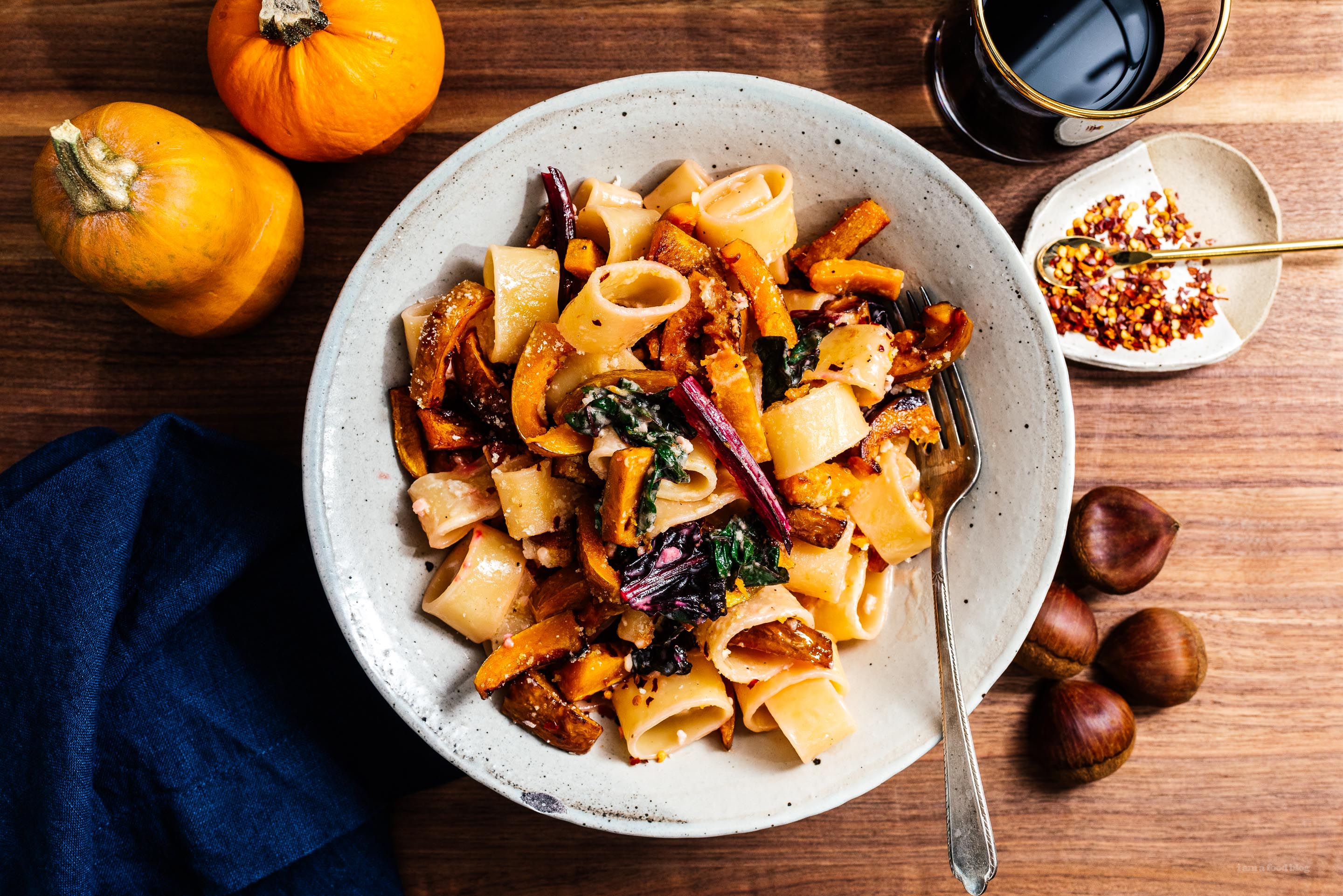




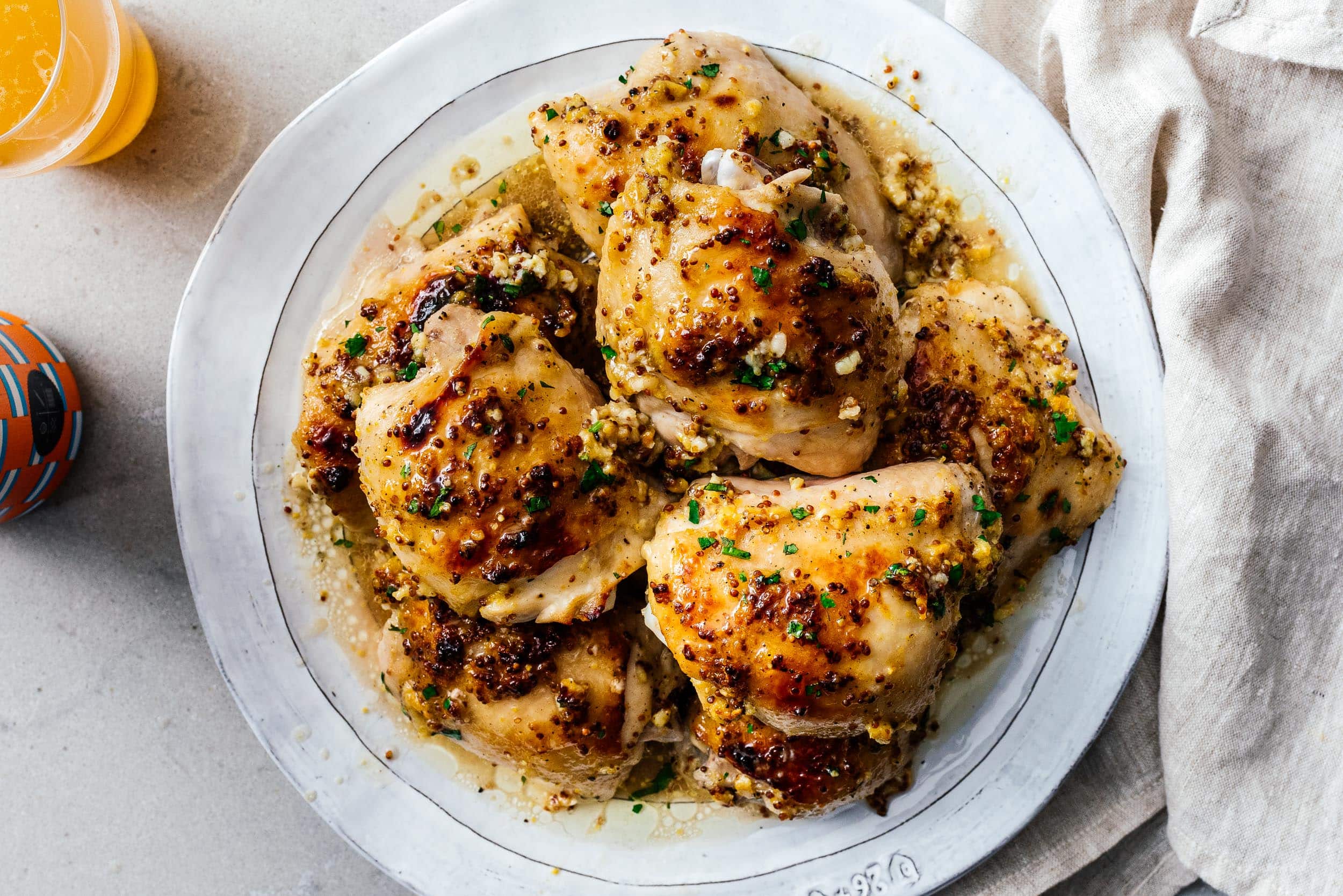
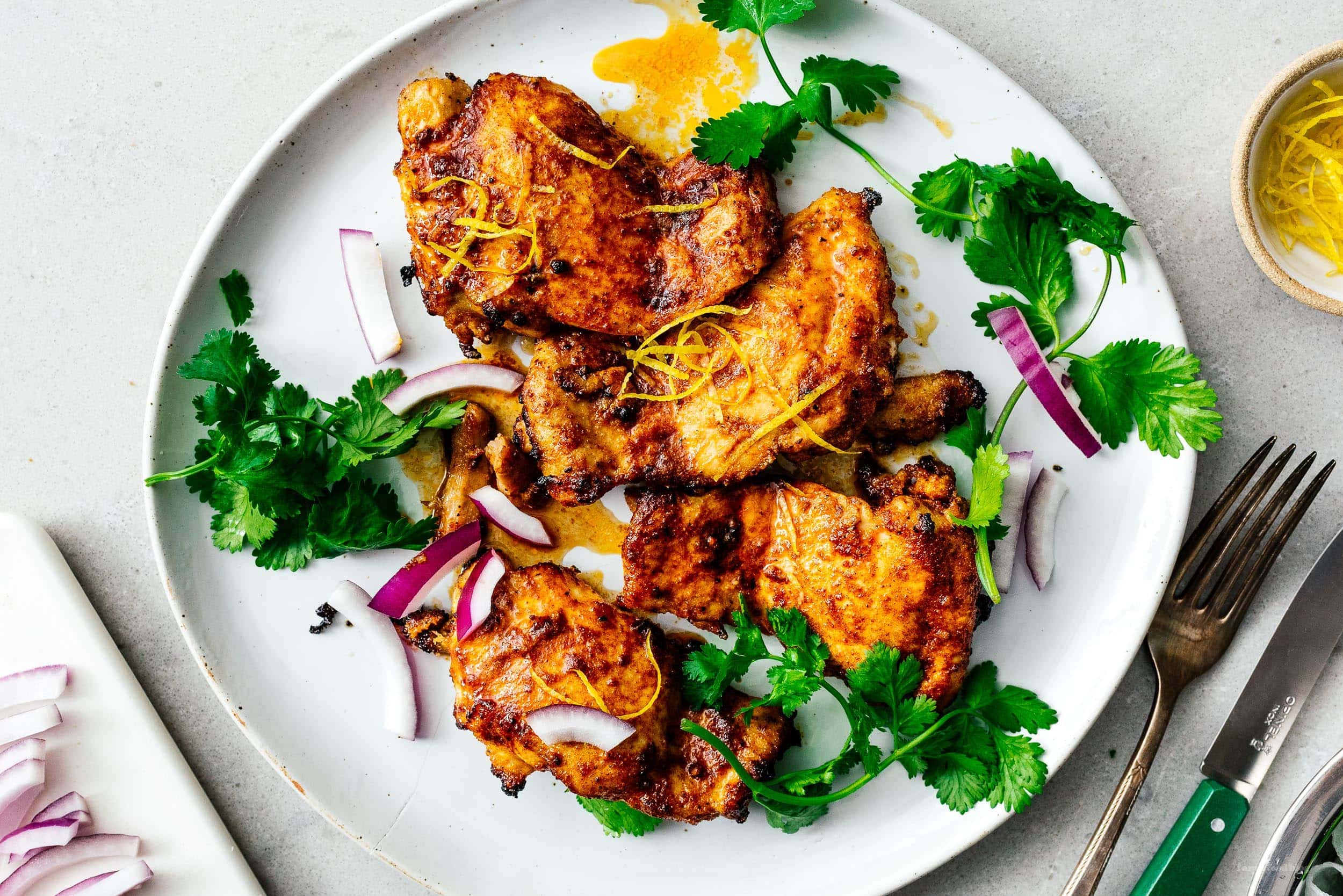
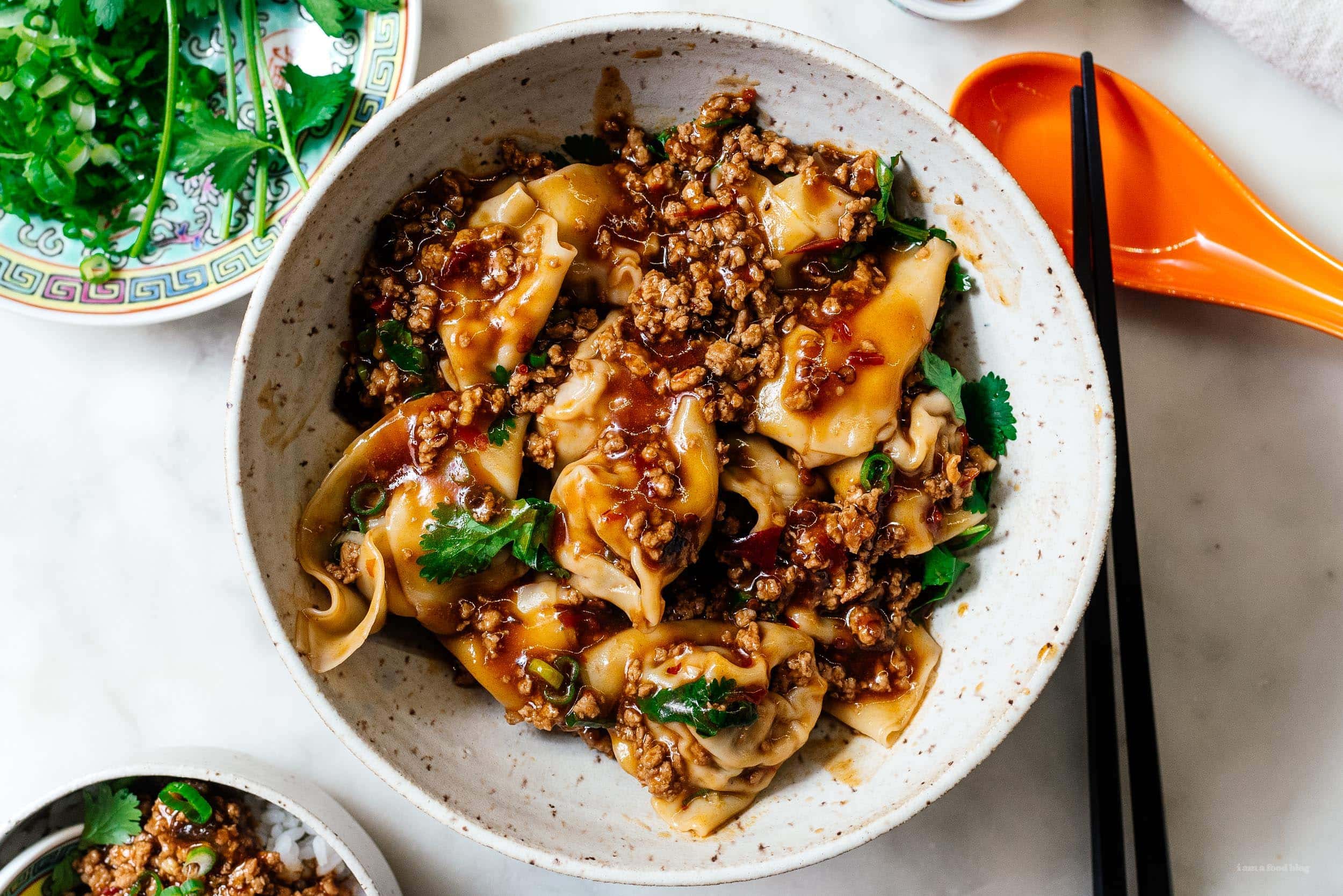
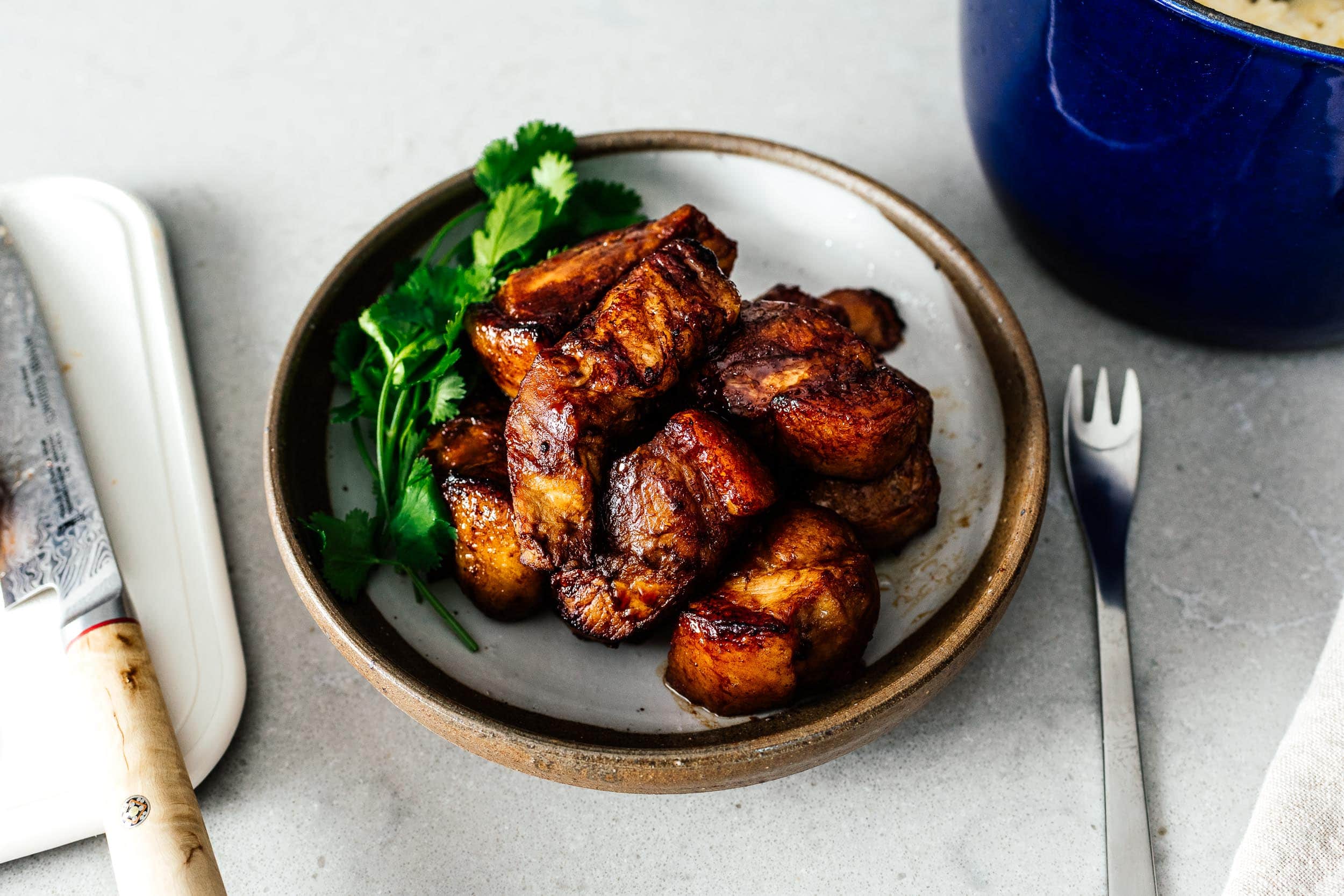
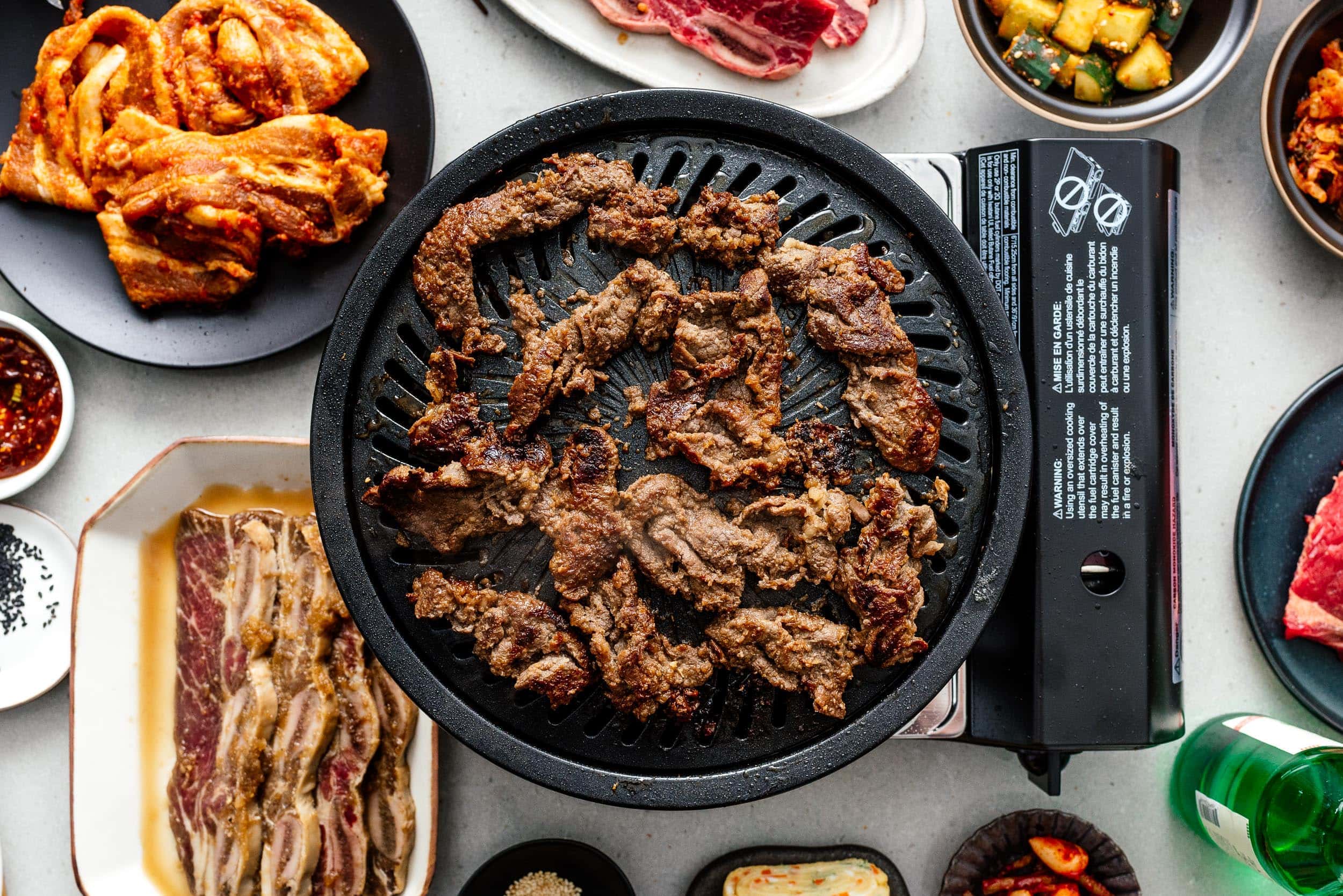
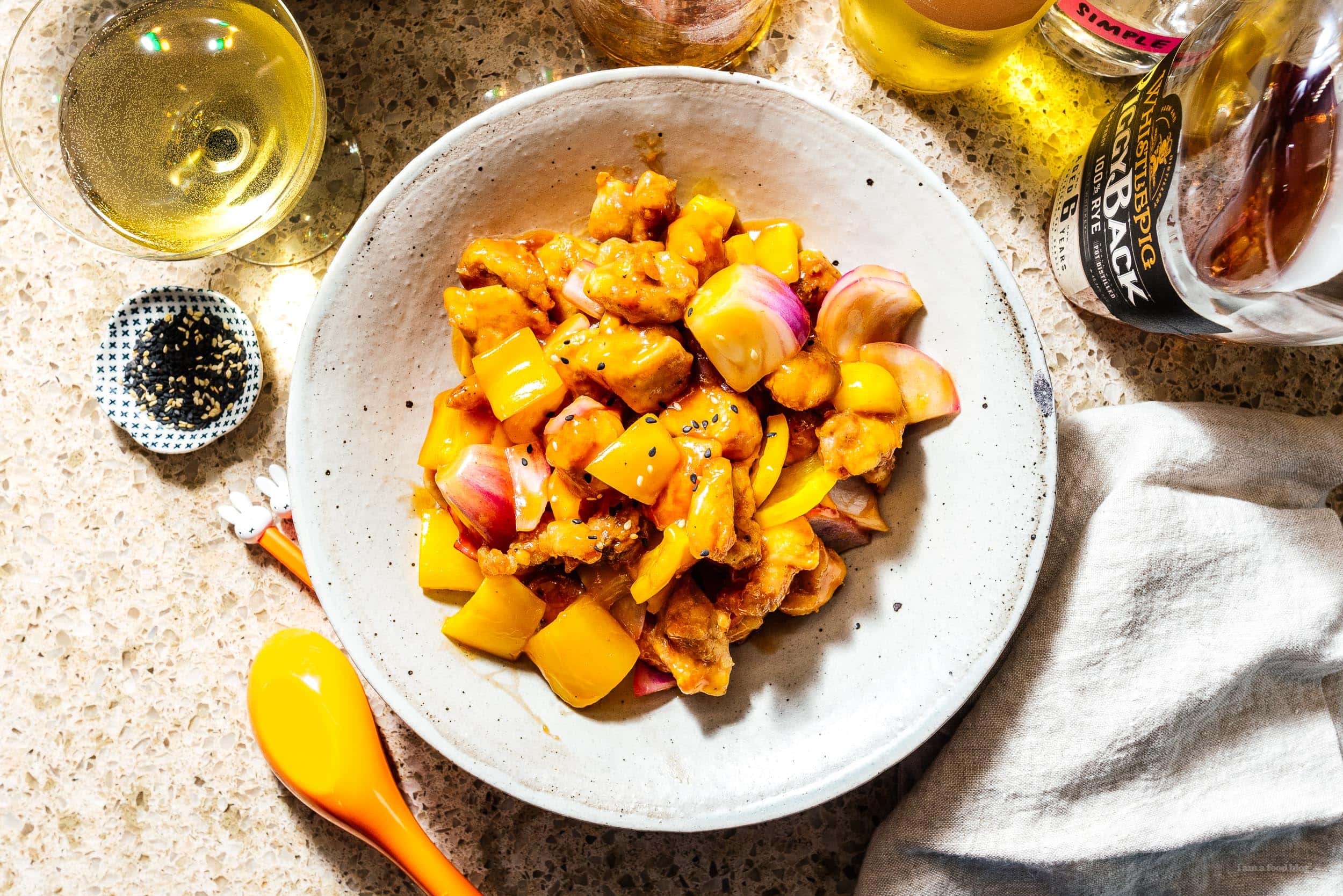

 2015 Holiday Giveaway
2015 Holiday Giveaway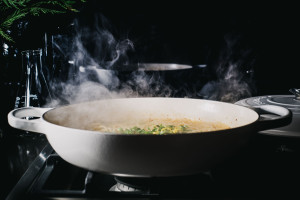 One-Pot Lemon Scallop Pea Spaghetti
One-Pot Lemon Scallop Pea Spaghetti Beer Battered Onion Rings, Jalapeno Aioli
Beer Battered Onion Rings, Jalapeno Aioli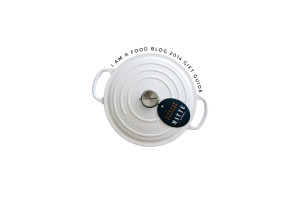 2014 Holiday Gift Guide and a Giveaway
2014 Holiday Gift Guide and a Giveaway Easy Gourmet Hot Wings and a Giveaway!
Easy Gourmet Hot Wings and a Giveaway!
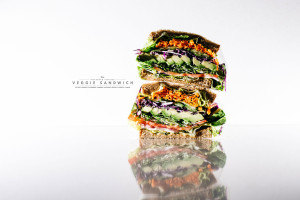 The Ultimate Veggie Sandwich
The Ultimate Veggie Sandwich Vegan(!) Creamy Corn Soup Recipe
Vegan(!) Creamy Corn Soup Recipe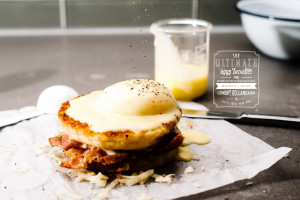 Sunday Brunch: Grilled Cheese Eggs Benny
Sunday Brunch: Grilled Cheese Eggs Benny